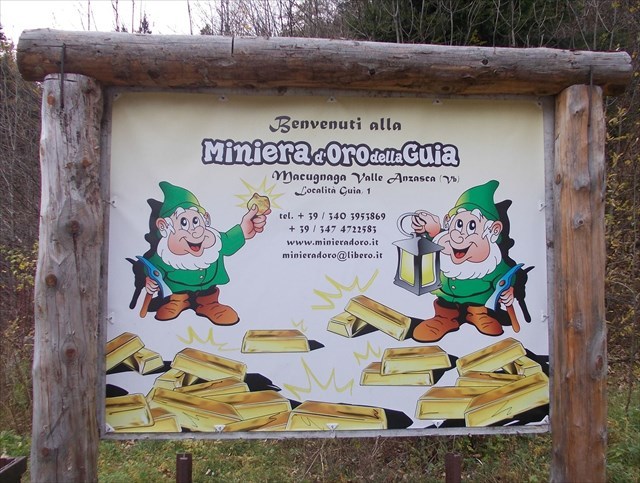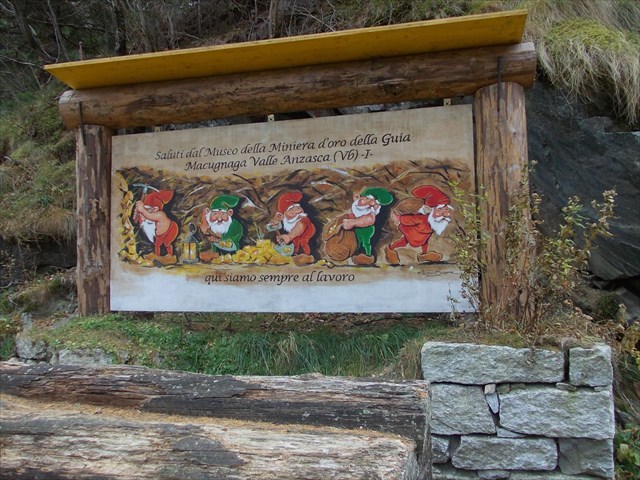[ITA] L’ORO DEL ROSA
I giacimenti auriferi del Monte Rosa sono, senza dubbio, i più importanti delle Alpi occidentali e la loro coltivazione si perde nella memoria storica. Le miniere d’oro della valle Anzasca sono infatti molto antiche e numerose: il loro sfruttamento è iniziato prima a opera dei Celti e poi dei Romani. Le attività minerarie ebbero però notevole sviluppo a partire dal 1500; dal 1800 e fino alla loro chiusura, le miniere furono gestite da una compagnia inglese, la “Monte Rosa Gold Mining Company”.
In Valle Anzasca, la valle che porta al monte Rosa, si trova sia oro primario, cioè intrappolato nella roccia madre, sia oro secondario, cioè alluvionale che si trova dunque in forma di pagliuzze nell’acqua dei fiumi. I giacimenti primari, rappresentati da filoni che si trovano nel massiccio del monte Rosa, avevano un tenore aurifero abbastanza buono: una ventina di grammi d’oro (o d’argento) per quintale di minerale. Le difficoltà e il lungo lavoro di rimozione dell’oro dalla roccia sterile hanno però determinato la chiusura delle miniere, non per esaurimento del minerale, ma per la scarsa redditività delle stesse dovuta soprattutto all’aumento del costo della manodopera. L’ultima miniera attiva è stata quella di Pestarena, chiusa nel 1961.

Presso l’abitato di Fornarelli di Macugnaga recentemente è stata riaperta la miniera d’oro della Guia, la prima miniera delle Alpi aperta alle visite turistico-culturali e la prima miniera-museo italiana. Lungo il suo percorso (1,5 km circa) è possibile scorgere autentici filoni di pirite aurifera.

I giacimenti auriferi, come abbiamo già detto, possono essere primari o secondari. Per giacimenti auriferi primari s’intende l’oro ubicato nel suo esatto luogo di formazione originaria, cioè sulle montagne ed in genere si trova all’interno di filoni quarzosi. Le vene si formano quando fluidi idrotermali contenenti oro e altri metalli provenienti dalla profondità della terra penetrano in rocce preesistenti. Ciò avviene grazie anche al fatto che questi fluidi consistono in acque e vapori con temperature di qualche centinaio di gradi (tra i 320° e i 380°C) e pressioni comprese tra 0,8 e 3 kbar.
Questo tipo di giacitura (primaria) si divide inoltre in giacimenti ad oro nativo che offrono la possibilità di trovare oro ben visibile ed incastonato nel quarzo oppure in mineralizzazioni costituite da solfuri auriferi; in questo caso l’oro è presente in forma minutissima all’interno di altri minerali. L’oro nativo, in genere molto più abbondante dei minerali d’oro, alimenta ben il 90% della produzione mondiale: allo stato puro è di colore giallo marcato, più chiaro se contiene argento e si riunisce in masserelle distribuite nei filoni di quarzo. L’oro nativo può essere grosso, piccolo, dendritico, cristallizzato, lamellare o associato ad altri minerali come pirite, blenda galena, calcite. L’oro nei solfuri invece è presente quasi sempre nella pirite aurifera che adeguatamente trattata fornisce oro perlopiù in polvere.
I giacimenti secondari o alluvioni aurifere (oro alluvionale) sono invece costituiti dall’oro che in lontanissimi tempi si trasferì dalle zone dei primari, distribuendosi molto più a valle nei terreni e nei fiumi. L’oro alluvionale proviene dalla remota epoca delle glaciazioni con i ghiacciai che ricoprivano le vallate montane e che si portavano appresso tutto quanto trovavano sul loro cammino, schiacciandolo e assottigliandolo. In un secondo momento, l’acqua ripulì questo oro, lo assottigliò ulteriormente e lo lucidò, trasportando così le scagliette d’oro sottilissime dette anche pagliuzze nei fiumi.

Domande:
- Cosa si intende per giacimento aurifero primario?
- Come si formano i filoni auriferi?
- Cos’è invece l’oro alluvionale?
- Spiega se “l’oro del Rosa” ha origine primaria o secondaria.
- Davanti al pannello di benvenuto della miniera della Guia si trovano dei macchinari indispensabili per l'attività estrattiva collegata a questo minerale. Cosa sono? Quanti sono e quante ruote hanno in tutto?
- Mi farebbe piacere una vostra foto nei pressi della Miniera della Guia. (FACOLTATIVO)
Per favore, inviate le risposte attraverso l'opzione messaggi sul nostro profilo; generalmente rispondiamo velocemente, dunque attendete la nostra autorizzazione al log.
[ENG] THE GOLD OF MONTE ROSA
The gold deposits of Monte Rosa are undoubtedly the most important in the western Alps and their mining is lost in historical memory. The gold mines of the Anzasca valley are indeed very old and numerous: their exploitation began first with the Celts and it then continued with the Romans. However, mining activities developed considerably starting from the 16th century; from the 19th century until their closure, the mines were run by an English company, the "Monte Rosa Gold Mining Company".
In the Anzasca valley, the valley that leads to Monte Rosa, there is both em>primary gold, trapped within mother rock, and secondary gold, that is alluvial gold which is found in the form of flakes in the water of rivers. Primary deposits, represented by veins found in the massif of Monte Rosa, had a fairly good gold content: around twenty grams of gold (or silver) per quintal of minerals. However, the difficulties and the long work of removing gold from sterile rock have led to the closure of the mines, not due to the exhaustion of the mineral, but because of the low profitability of the same, due mainly to the increase in labour costs. The last active mine was that of Pestarena, closed in 1961.

In the locality of Fornarelli in Macugnaga, the Guia gold mine has recently been reopened. This is the first mine in the Alps open to cultural and tourist visits and the first Italian mine-museum. Along its path (about 1.5 km), it is possible to see authentic veins of gold-bearing pyrite.

As already said, gold deposits can be primary or secondary. Primary gold deposits are those in which the gold is located in the exact place of its original formation, that is on the mountains, and this is usually found inside quartz veins. Veins are formed when hydrothermal fluids containing gold and other metals from the depths of the Earth penetrate into pre-existing rocks. This is also due to the fact that these fluids consist of water and vapours with temperatures of several hundred degrees (between 320° and 380°C) and pressures between 0.8 and 3 kbar.
This type of (primary) deposit is also divided into native gold deposits that offer the possibility of finding gold clearly visible and embedded in quartz or in mineralisations consisting of gold solfures, in which case gold is present in very fine form within other minerals. Native gold, generally much more abundant than gold minerals, feeds 90% of world production: in its purest form, it is of a marked yellow colour, lighter if it contains silver and is gathered in masses distributed in quartz veins. Native gold can be large, small, dendritic, crystallised, lamellar or associated with other minerals such as pyrite, galena, calcite. Gold in sulphides is instead almost always present in the gold pyrite that, when properly treated, provides mostly gold powder.
Secondary deposits or gold floods (alluvial gold) are instead made up of gold that in ancient times moved from areas of primary deposits, dispersing much further downstream in soils and rivers. Alluvial gold comes from the remote era of glaciations, when the glaciers covering mountain valleys and carrying along everything they found on their way crushed and thinned it. Later on, water cleaned this gold, thinned it further and polished it, transporting very thin spangles, also known as gold flakes, into the rivers.

Questions:
- What is meant by primary gold deposit?
- How do gold veins form?
- What is alluvial gold?
- Explain whether "The gold of Monte Rosa" has primary or secondary origin.
- In front of the Guia mine's welcome panel, there are some machines that are essential for the mining of this mineral. What are they? How many are there and how many wheels do they have in total?
- I would like to see a picture of you near the Guia mine. (OPTIONAL)
Please send all the answers via the ‘Send message’ option on our profiles; we usually reply quite quickly, so wait for us to give you the green light to log.